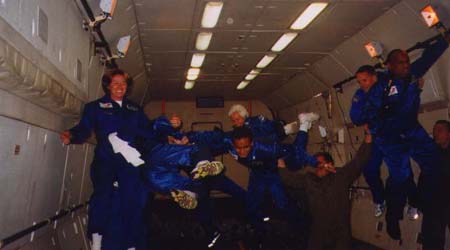During my visit to Star City, we spent about half a day hearing about medical experiments carried out on Mir, and one of the discussions touched on this issue. In zero-g, there is little need for bones. So your body gets rid of them, by slowly re-absorbing them. And where do the bones go? Into your urine - and that means through your kidneys, where some of that calcium gets laid down as a kidney stone. Apparently several of the long-term stays on Salyut 7 and Mir involved cases of kidney stones. The interesting/scary part (and one that is often not discussed) is that space travellers never truly recover the original full bone density after returning to Earth. Stay in space long enough, and you can't come back.
Enough of the bone is dissolved that osteoporosis is a demonstrated serious problem for long-duration spaceflight. We could get to Mars, but there would be a high risk of a bone fracture once we were on the surface. Bone can be lost at a rate of up to 1% a month, possibly topping out at about 40 to 60% loss.
"Houston, we have a problem. Fred is crawling around on his hands and knees, holding his ankle. Umm... and now he's on his face in the red dust... oh never mind, he... well, ...dissolved."
The first thing spacefarers find when they get to orbit is the space-sickness issue. I have to admit that I would probably be quite vulnerable -- we did ten parabolic arcs on the Ilyushin 76 (the Russian "Vomit Comet," shown below), and within six arcs I was looking pretty green.


The next day, sitting in the Buran control panel mockup inside the planetarium, the whirling stars made all our inner ears spin, and our ever-present minder, Natasha, fled in a blur. Even a week later, watching a video of a tour of the Space Station on television, with the camera twisting and turning through passageways, I had to turn my head away.
Even veteran space travellers suffer from these vestibular problems. Their incidence is not predictable - hardened combat pilots can get severe bouts, and known sea-sickness sufferers can be immune. Newly adapting crews on the Station often spend a day or two carefully aligning themselves with the writing on the station walls, which is all written in one orientation to help minimize space-sickness problems.
The next thing space travellers encounter is the rearrangement of bodily fluids. We don't realize it, but we perform this cycle each day here on Earth. During the daytime our legs swell and our heads shrink because fluids drain towards the floor. At night, they balance out, to start again the next day. The change isn't really noticeable unless we get it wrong - stand on your head, or sleep on a sloping bed, and you will quickly feel the pressure change (when vertical, the gradient goes from about 200 mmHg at the lowest body point to 60 mmHg at the highest body point).
In space there is no fluid pooling in the legs, so the feeling one gets is one of puffiness. People's faces look puffy for the first few days (the body first equalizes at about 100 mmHg throughout). The brain is very sensitive to partial pressures and fluids, so the body begins to eliminate fluid to lower the pressure. Dehydration is an automatic response to this weightless condition. Most people lose about 20% of their blood volume. Valeri Korzun told me that he didn't urinate for three days after returning to Earth - his body was re-hydrating to be able to tolerate the fluid pooling cycle, and to keep blood pressure high enough in the brain when he stood erect in one-g.
To simulate the pull of gravity, crews have tried lowering the atmospheric pressure around the lower half of the body. Here astronauts Kerwin and Weitz aboard Skylab try the U.S. system, which consisted of a 'canister' with a skirt that sealed around the waist (Lower Body Negative Pressure, LBNP).

The Russians on Mir tried this also, with a set of pants called Chibis, modeled here by Brian Walker:

(anybody remember Nick Park's "The Wrong Trousers"?)
Inefficient record-keeping, poor experiment design, and loss of materials has meant that much of the valuable medical information gained from the Soviet and Russian long-duration programs has unfortunately been lost. Much of the experimentation that was to have been carried out on the ISS is also now in jeopardy due to the reduction in crew. Even before the Columbia accident, the reduced ISS crew level was insufficient for proper protocols in many experiments.
We may be reduced to learning on-the-
fly when we go to Mars. Russian-style.